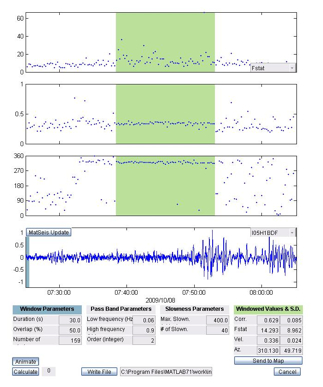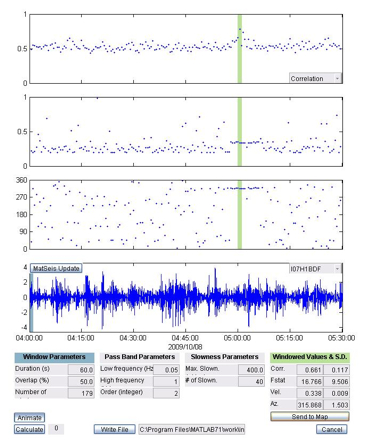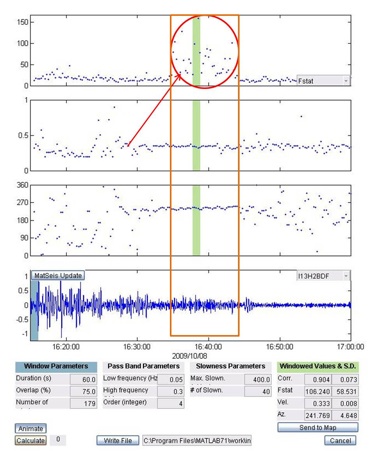On October 8, 2009 about 03:00 Greenwich time, an atmospheric fireball blast was observed and recorded over an island region of Indonesia. The blast is thought to be due to the atmospheric entry of a small asteroid about 10 meters in diameter that, due to atmospheric pressure, detonated in the atmosphere with an energy of about 50 kilotons (the equivalent of 110 million pounds of TNT explosives).
The blast was recorded visually and reported upon by local media representatives. See the YouTube video at:
http://www.youtube.com/watch?v=yeQBzTkJNhs&videos=jkRJgbXY-90
A report from Elizabeth Silber and Peter Brown at the University of Western Ontario indicates that several international very-long wavelength infrasound detectors recorded the blast and fixed the position near the coastal city of Bone in South Sulawesi, island of Sulewesi. They note that the blast was in the 10 to 50 kT range with the higher end of this range being more likely.
Assuming an estimated size of about 5-10 meters in diameter, we would expect a fireball event of this magnitude about once every 2 to 12 years on average. As a rule, the most common types of stony asteroids would not be expected to cause ground damage unless their diameters were about 25 meters in diameter or larger.
A more extensive report by Elizabeth Silber and Peter Brown of the University of Western Ontario is here.
Elizabeth Silber and Peter Brown Meteor Infrasound group Dept. of Physics and Astronomy, Univ. of Western Ontario London, ON N6A 3K7 CANADA Released: October 19, 2009
On Oct 8, 2009, media reports appeared in the local press in Indonesia concerning a loud air blast occurring near 11am local time (0300 UT). Subsequent to these first media reports, additional English language reports appeared suggesting the event was meteoritic.
Indonesian language reports more clearly identify a bright fireball, accompanied by an explosion and lingering dust cloud as the origin of the air blast. Finally, a YouTube video posted on the same day appears to show a large dust cloud consistent with a bright, daylight fireball.
http://www.surya.co.id/2009/10/09/ledakan-misterius-guncang-sulsel.html
http://www.youtube.com/watch?v=yeQBzTkJNhs&videos=jkRJgbXY-90
Based on these initial reports, a detailed examination was made of all International Monitoring System (IMS) infrasound stations of the Comprehensive Nuclear-Test-Ban Treaty Organization (CTBTO). From this initial examination, a total of 11 stations showed probable signals from a large explosion centered near 4.5S, 120E, with an origin time near 0300 UT on Oct 8, 2009, consistent with the media reports. This signal was notable for having been (a) detected at many IMS stations, including five at ranges over 10,000 km (and one at a nearly 18,000 km range) and (b) being confined to very low frequencies. Both of these observations suggest the explosion source was of very high total energy. All signal motions were between 0.27 - 0.32 km/s, consistent with stratospheric signal returns.
We have used the Air Force Technical Application Centre (AFTAC) period-yield relation as described by ReVelle (1997) as the most robust basic indicator of source energy. To generate measured periods, the average periods of all phase-aligned stacked waveforms at each station were measured, according to the technique described in Edwards et al (2006). These periods were then averaged to produce a single, global average period of 13.4 sec and the AFTAC yield relation applied; this produced an average source yield of 31 kT of TNT. Averaging the individual yields from all stations produces a mean source energy near 50 kT of TNT while using only the eight stations having the highest signal-to-noise-ratio (SNR) and using the local observed periods of the waveform at maximum amplitude produces a yield estimate of 40 kT of TNT, all of which are basically consistent. It is important to note, however, that the standard deviation of this measurement is nearly 30 kT. That is, the best source energy estimate would be 40 +/- 30 kT TNT. Note that much of this variation may be due to the signal emanating from different portions of the fireball trail as observed at different stations; each period measurement is a “sample” of the size of the cylindrical blast cavity at that particular segment of the trail detected by any one station. As such, the out of atmosphere yield for this event is likely higher than these measurements suggest - very probably in the ~50 kT range.
The yield estimates based on infrasonic amplitude are very uncertain in this instance as the propagation distances are much larger than is typical and outside the range limits where such relations have been developed (e.g. Edwards et al, 2006) and hence the period relationship (which was generated using a dataset of nuclear explosions having yields in this range) is more applicable.
Some examples of the detected and processed waveforms are shown in the appendix.
Based on these infrasound records, it appears that a large (40-50 kT TNT) bolide detonation occurred near 0300 UT on Oct 8, 2009 near the coastal city of Bone in South Sulawesi, Indonesia. The infrasonic geolocation is not precise enough to determine if the bolide was over water or land, but it was relatively near the coast.
Follow-on observations from other instruments or ground recovery efforts would be very valuable in further refining this unique event.
Using an average impact velocity for NEAs of 20.3 km/s, the energy limits (10 - 70 kT) suggested by this analysis correspond to an object 5-10 m in diameter. Based on the flux rate from Brown et al (2002), such objects are expected to impact the Earth on average every 2 - 12 years.
Brown P., Spalding R.E., ReVelle D.O., Tagliaferri E. and Worden S.P. 2002. The flux of small near-Earth objects colliding with the Earth, Nature, 420, 314-316.
Edwards W.N., Brown P.G., ReVelle D.O., 2006. Estimates of Meteoroid Kinetic Energies from Observations of Infrasonic Airwaves, Journal of Atmospheric and Solar-Terrestrial Physics, 68: 1136-1160.
ReVelle D.O. 1997. Historical Detection of Atmospheric Impacts by Large Bolides using Acoustic-Gravity Waves, Annals of the New York Academy of Sciences, Near-Earth Objects - The United Nations International Conference, editor J.L. Remo, New York Academy of Sciences, 822, 284-302.
In each of the following the infrasound signals across each station have been array processed in windows (typically of 30-60 second length) to search for coherent signals with consistent back-azimuth measurements. The top panel in each display is the F-statistic, a measure of the relative coherency of the signal across the array elements in any particular window (essentially a SNR measure). The second window shows the apparent trace velocity of the acoustic signal across the array in the direction of the peak F-stat. Similarly, the third plot shows the best estimate for the signal back-azimuth in the direction of maximum F-stat for each window. The fourth plot shows the raw pressure signal for one array element bandpassed according to the chosen Low - High frequency combination, shown in the boxes of the lower plot.


